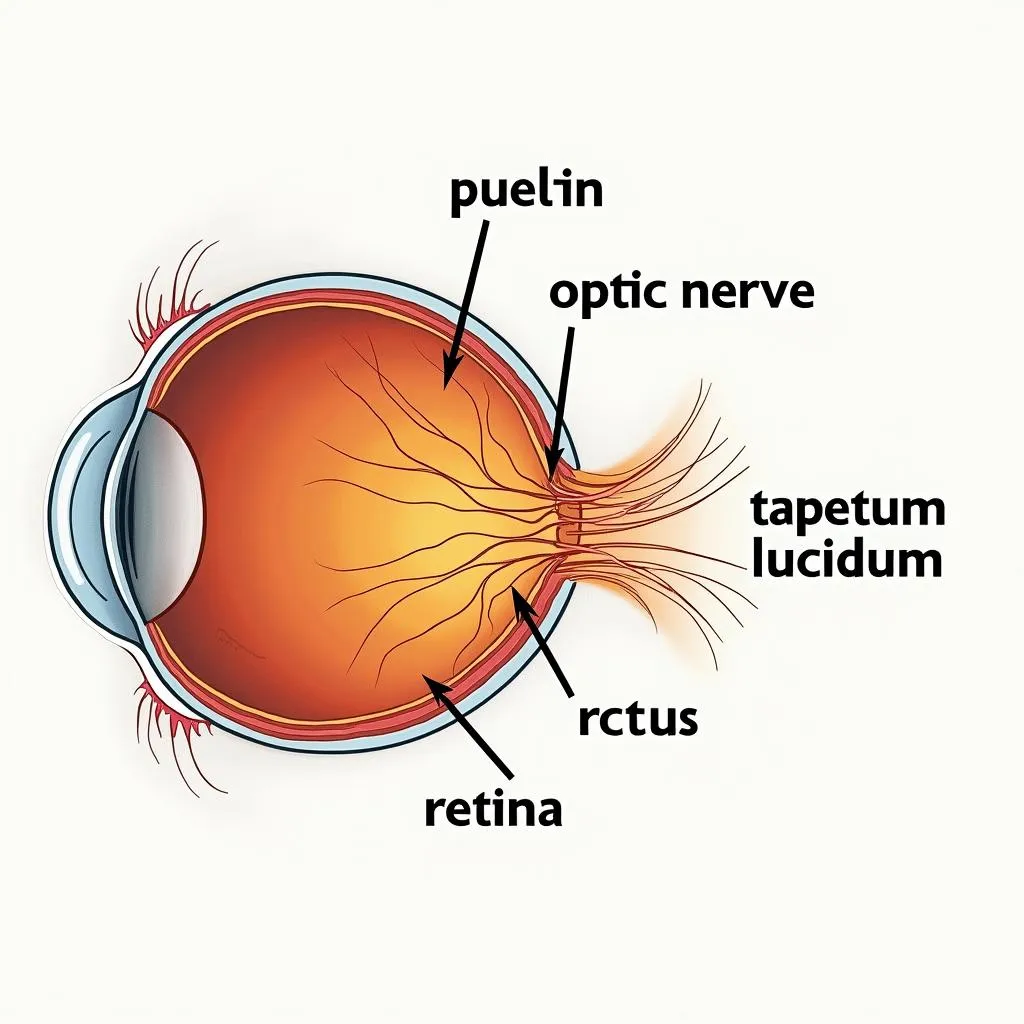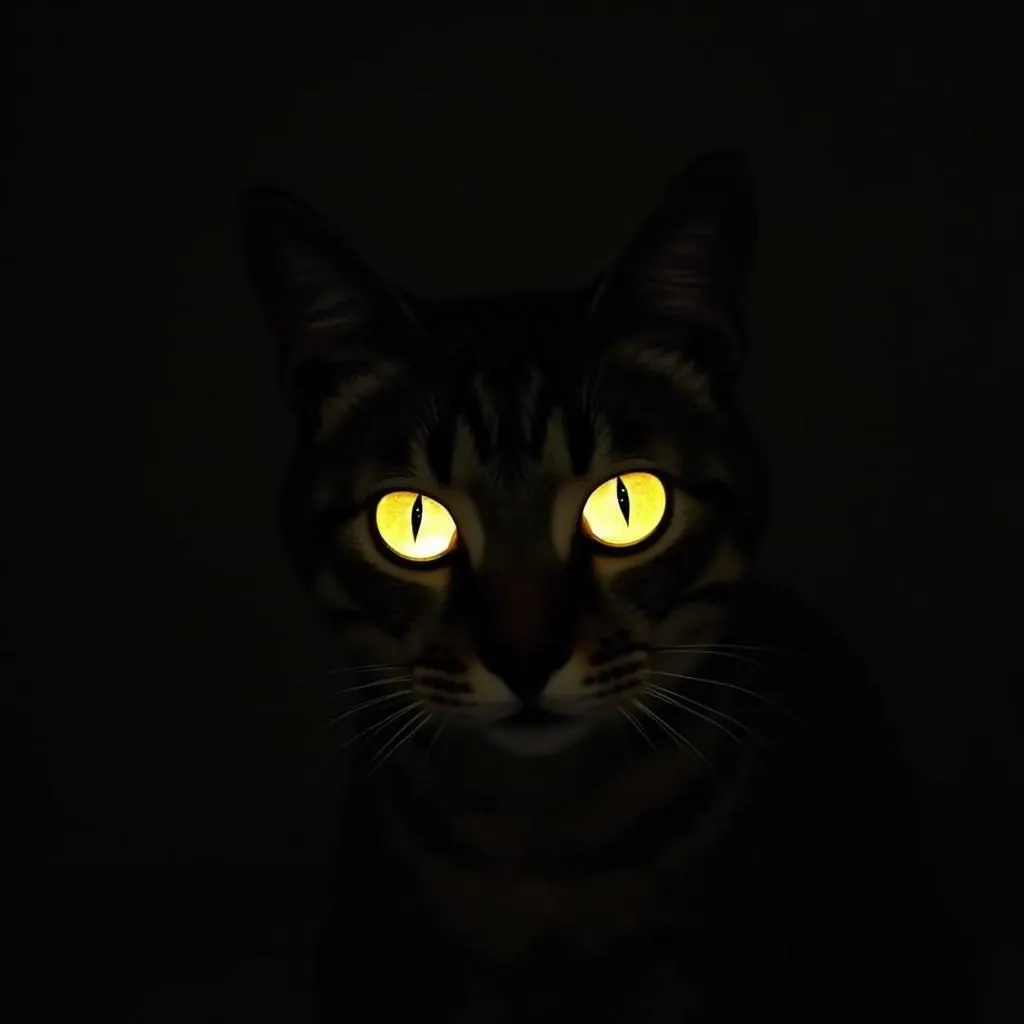Have you ever noticed a cat’s eyes shimmering in different shades throughout the day? It’s easy to wonder, “Do cat eyes change color?” The answer is a resounding yes! But it’s not quite like changing your hair color. Let’s unravel the fascinating reasons behind this feline phenomenon.
The Science Behind Shimmering Cat Eyes
A cat’s eye color isn’t just about aesthetics; it’s a testament to their incredible vision. The color-changing ability stems from a structure in their eyes called the tapetum lucidum, a reflective layer located behind the retina. This layer acts like a mirror, reflecting light back through the retina, giving their photoreceptor cells a second chance to absorb light. This is particularly beneficial in low-light conditions, allowing cats to see much better than humans in dim environments.
The color change we perceive is due to the variation in how much light is reflected by the tapetum lucidum depending on the amount of available light. In bright light, the pupils constrict to a thin slit, and the tapetum lucidum reflects less light, making the eye color appear more intense. As light diminishes, the pupils dilate to allow more light in, causing the tapetum lucidum to reflect more light and resulting in a more vibrant or glowing effect.
 Cat Eye Anatomy
Cat Eye Anatomy
Factors Influencing Cat Eye Color Change
While all cats possess a tapetum lucidum, the intensity and specific hues of their eye color change can vary based on several factors:
- Breed: Certain breeds are predisposed to specific eye colors. For instance, Siamese cats typically have blue eyes, while copper eyes are common in Persian cats. These breed-specific traits are linked to the pigmentation and structure of the iris.
- Age: Similar to humans, a cat’s eye color can change subtly as they age. Kittens are born with blue eyes due to a lack of melanin. As they grow, melanin production increases, leading to their true eye color developing gradually over several months.
- Mood: While not as dramatic as chameleons, a cat’s mood can influence its eye color subtly. When a cat is agitated, frightened, or excited, its pupils dilate, potentially making the eye color appear brighter or more intense due to the increased reflection from the tapetum lucidum.
Dispelling the Myths: Cat Eyes Don’t Glow in the Dark
Despite common belief, cat eyes don’t actually “glow in the dark.” The tapetum lucidum reflects existing light rather than generating its own. In complete darkness, a cat’s eyes wouldn’t glow. However, even the faintest light source, like moonlight or distant streetlights, can be reflected, creating the illusion of glowing eyes.
 Cat with Glowing Eyes at Night
Cat with Glowing Eyes at Night
Beyond Color Change: The Marvel of Cat Vision
The color-changing ability of cat eyes is just one aspect of their remarkable vision. Cats possess a wider field of view than humans, allowing them to see more of their surroundings. They also excel at detecting motion, making them adept hunters. While their visual acuity might not be as sharp as ours in bright light, their superior night vision and motion detection capabilities more than compensate, making them perfectly adapted for their crepuscular lifestyle.
Understanding Your Feline Companion
Observing the subtle changes in your cat’s eye color can provide insights into their mood, health, and environment. A sudden or drastic change in eye color, especially if accompanied by other symptoms like discharge, cloudiness, or redness, could indicate an underlying health issue. It’s crucial to consult with a veterinarian if you notice any unusual changes in your cat’s eyes.
Conclusion
The next time you catch your feline friend’s eyes shimmering in a different shade, remember the fascinating science behind it. Their color-changing eyes are not just beautiful but a testament to their evolutionary adaptation and remarkable visual capabilities. Understanding these changes can deepen our appreciation for our feline companions and help us better care for their well-being.
FAQs
1. Do all cats’ eyes change color?
Yes, all cats possess a tapetum lucidum, the reflective layer responsible for the color-changing effect in their eyes. However, the intensity and specific hues can vary based on breed, age, and even mood.
2. What colors can cat eyes change to?
The most common colors observed are green, yellow, and blue. However, the exact shades can vary significantly depending on the cat’s breed and individual pigmentation.
3. Why do cats’ eyes seem to glow in the dark?
Their eyes don’t actually glow. The tapetum lucidum reflects existing light, even faint sources like moonlight, creating the illusion of glowing eyes.
4. Can a change in my cat’s eye color be a sign of illness?
While subtle changes can be normal, a sudden or drastic change, especially if accompanied by other symptoms like discharge or cloudiness, could indicate an underlying health issue. Consult with your veterinarian if you notice any unusual changes.
5. How does a cat’s vision compare to a human’s?
Cats have superior night vision and motion detection capabilities, but their visual acuity might not be as sharp as ours in bright light. They also possess a wider field of view, allowing them to see more of their surroundings.
6. Can a cat’s eye color change permanently?
While a cat’s eye color might experience subtle changes with age, drastic and permanent changes are unusual. If you observe significant changes, consult your veterinarian to rule out any underlying health concerns.
7. What is the purpose of the tapetum lucidum in cats?
The tapetum lucidum acts like a mirror behind the retina, reflecting light back through the eye and enhancing their vision, especially in low-light conditions.
